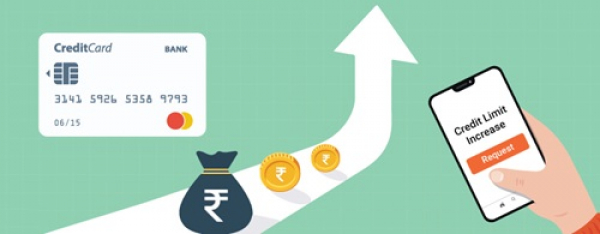How to Increase Credit Card Limit: A Step-by-Step Guide
- by B2B Desk 2024-07-08 12:09:31
Credit cards offer unparalleled convenience in today's society, serving as a primary method for shopping and bill payments for many. However, their defining feature is the credit limit, which imposes a cap on monthly expenditures.
The rationale behind setting a credit limit is clear: it prevents individuals from overspending beyond their financial means. This precaution is essential because exceeding the limit can result in challenges when repaying the outstanding balance. Additionally, it may lead to significant costs in the form of interest payments to the credit card issuer.
Credit limits are not standardized and can vary significantly between different card issuers and even among individual users. When determining the appropriate limit for each cardholder, credit card companies take into account a range of factors, including the individual's credit history, income level, and overall creditworthiness.
What is a Credit Card Limit?
A credit card limit is the maximum amount you can spend within a billing cycle without incurring penalties. This limit is determined by the issuing bank and varies from person to person.
Several factors are taken into consideration when setting your credit card limit. These factors include the type of credit card you have, your income level, your ability to repay debts, your credit score, your payment history, and your existing financial obligations. Essentially, your entire credit profile undergoes thorough scrutiny to establish this spending threshold.
It's crucial to adhere to your credit card limit. Once you reach this maximum amount, your card issuer may reject any further transactions. Going over the limit can result in penalties and fees, which can negatively impact your financial well-being. Moreover, your credit limit affects your overall credit score.
Fortunately, there's a practical solution to manage these concerns: requesting a credit limit increase. This option can be particularly advantageous if you anticipate upcoming significant expenses to increase your credit card limit.
How Banks Calculate the Credit Limit on Your Credit Card
The credit card limit you're given is primarily based on your creditworthiness. When you apply for a credit card, banks and financial institutions assess factors like your credit score, income, employment status, spending patterns, age, existing debt, and credit history to determine your limit.
Some banks offer credit cards with predefined limits. For instance, a card may come with a fixed limit of INR 2 lakh for all applicants choosing that product. Other institutions may conduct a more detailed assessment before approving higher limits for their customers.
If you're new to credit and don't yet have a credit score, you might initially receive a lower credit limit. In such cases, banks rely on your initial spending and payment behavior to build trust. By consistently making timely payments and demonstrating responsible financial habits, you can expect your credit limit to increase gradually over time.
Elements that impact your credit limit
The amount of credit you're approved for depends on several factors: how trustworthy you are with credit, your income, how much of your income goes toward debt payments, and your credit history. Let's explore these factors further.
Creditworthiness
Your credit score reflects how responsibly you've handled credit in the past. Individuals with higher scores (750 and above) are eligible for credit cards with generous limits, whereas those with lower scores may encounter difficulties securing loans. This underscores the importance of building your creditworthiness by consistently monitoring your credit accounts.
Credit utilization
Before approving new credit, banks and credit card issuers also evaluate your credit utilization, which refers to the percentage of your available credit that you currently use.
If you consistently max out your credit card, the issuer might see you as someone who constantly needs credit and could decline your application. So, it's crucial to keep your credit utilization in check. At the same time, it's important to keep your credit cards active. Don't throw away your old cards; use them occasionally to maintain a healthy credit history.
Income and debt ratio
Your debt-to-income ratio (DTI) indicates how well you can manage your credit obligations. Lenders use this ratio to evaluate your ability to repay new credit. It's calculated by comparing your monthly income with your current financial commitments, such as loan payments and credit card bills. A lower DTI ratio increases your likelihood of obtaining a higher credit limit.
How to Increase Credit Card Limit
Use your card often
Using your card frequently provides more opportunities to demonstrate your financial responsibility to the bank. By making regular payments and ensuring your bills are paid on time, you create a positive impression with your credit card provider. This benefits you in two main ways. Firstly, it increases the likelihood that the bank will raise your credit limit, viewing you as a trustworthy customer. Some banks may even raise your limit automatically if you agreed to it during your application. Secondly, frequent card use allows you to take advantage of cashback, rewards, and other benefits offered by your card.
Enhance your credit score by consistently making your payments on time
Your credit score, a three-digit number ranging up to 900, indicates your ability to manage and repay debts. A higher score is advantageous. It's important to regularly monitor your credit score if you use credit cards or have outstanding loans. Missing bill payments or deadlines can lower your score, especially if you have multiple credit cards and loans simultaneously.
To maintain a good credit score, limit your debt and ensure timely repayment of existing loans according to their EMI schedules. This responsible approach builds credibility with lenders, increasing your chances of securing higher credit limits in the future.
Show your income proof
Your income is the primary factor that determines your credit card limit. Providing updated proof of income is crucial for obtaining the credit limit you desire from banks. Typically, banks do not proactively increase credit limits for existing customers. By submitting your payslips and keeping your information updated with the bank, you improve your chances of securing higher limits.
Stay below your credit limit
Avoid spending all of it. A credit card is essential for aiding you during emergencies. It is recommended to spend around 30% to 40% of your credit limit to show that you are not relying heavily on your credit card for expenses, as low credit utilization is ideal. Cutting back on expenses will also help you settle your debts effortlessly and boost your credit rating.
FAQs
Q. How can I increase my credit card limit?
A. Pay your bills on time and reduce outstanding debts. Contact your Bank and request for a limit increase if your financial situation has improved. Keep your Credit Card balance below your limit; ideally, aim for below <30>% utilisation. Check your Account for pre-approved limit increases or offers from your Card issuer.
Q. How to get 50k credit limit?
A. If you have excellent credit, high income and low credit utilization among other variables, issuers may offer you a credit line of $30,000 to $50,000. However, it's possible credit issuers offer a credit limit even higher than that.
Q. What is the highest credit card limit?
A. On our list, the card with the highest reported limit is the Chase Sapphire Preferred® Card, which some say offers a $100,000 limit. We've also seen an advertised maximum credit limit of $100,000 on the First Tech Odyssey Rewards™ World Elite Mastercard®, a credit union rewards card.
Q. Can I request a credit limit increase?
A. You can contact your issuer to request a credit line increase. It's also not unusual for issuers to increase credit limits automatically.
Also Read: Union Budget 2024: What is an interim budget? Its significance during transitions
POPULAR POSTS
Loan EMIs to Drop as RBI Slashes Repo Rate - Full MPC December 2025 Highlights
by Shan, 2025-12-05 11:49:44
Zoho Mail vs Gmail (2025): Which Email Platform Is Best for Businesses, Startups, and Students?
by Shan, 2025-10-09 12:17:26
PM Modi Launches GST Bachat Utsav: Lower Taxes, More Savings for Every Indian Household
by Shan, 2025-09-24 12:20:59
$100K H-1B Visa Fee Explained: Trump’s New Rule, Clarifications & Impact on Indian Tech Workers
by Shan, 2025-09-22 10:11:03
India-US Trade Deal Soon? Chief US Negotiator Arrives in Delhi as Talks Set to Begin Tomorrow
by Shan, 2025-09-15 11:54:28
Modi Meets Xi: Trump’s Tariffs, Strategic Autonomy, and the Future of Asia’s Power Balance
by Shan, 2025-09-03 06:40:06
Google Claims Gemini AI Uses Just ‘Five Drops of Water’ Per Prompt, Sparks Debate
by Shan, 2025-08-22 12:34:27
RECENTLY PUBLISHED

Pine Labs IPO 2025: Listing Date, Grey Market Premium, and Expert Outlook
- by Shan, 2025-11-05 09:57:07

The Agentic Revolution: Why Salesforce Is Betting Its Future on AI Agents
- by Shan, 2025-11-05 10:29:23

Top 10 Insurance Companies in India 2026: Life, Health, and General Insurance Leaders Explained
- by Shan, 2025-10-30 10:06:42

OpenAI Offers ChatGPT Go Free in India: What’s Behind This Big AI Giveaway?
- by Shan, 2025-10-28 12:19:11

Best Silver Investment Platforms for 2025: From CFDs to Digital Vaults Explained
- by Shan, 2025-10-23 12:22:46





 Subscribe now
Subscribe now 